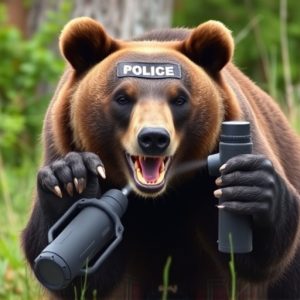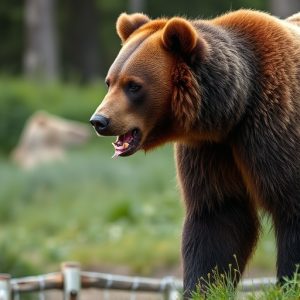Mastering Alaska Bear Spray Fog Pattern for Optimal Protection
Understanding bear spray fog patterns is vital for safety in Alaska's wilderness. The optimal r…….
Understanding bear spray fog patterns is vital for safety in Alaska's wilderness. The optimal range for effectiveness (20-30 feet or 6-9 meters) coats bears with a blinding, irritating cloud of capsaicin. Factors like wind direction and speed, temperature, humidity, and terrain influence this distance, which can extend to 30 feet in open areas but decrease to 15-20 feet in forests. Aiming at the bear's face and body while maintaining visibility ensures maximum protection, complementing training, awareness, and distance as primary defenses against bears.
Alaska’s rugged landscape demands knowledge of bear spray techniques for safety. Understanding the fog pattern is key to effective protection. This guide delves into the science behind bear spray fog, exploring factors like wind and terrain that influence its reach, known as the ‘best distance for bear spray effectiveness’. We provide strategies for optimal application and real-world case studies demonstrating successful usage. Equip yourself with this vital knowledge for navigating Alaska’s wilderness responsibly.
- Understanding Bear Spray Fog Patterns: What You Need to Know
- Factors Influencing the Best Distance for Bear Spray Effectiveness
- Strategies for Optimal Bear Spray Application and Coverage
- Case Studies: Real-World Scenarios and Their Spray Fog Distances
Understanding Bear Spray Fog Patterns: What You Need to Know
Understanding bear spray fog patterns is key to ensuring your safety in Alaska’s wild environments. Bear spray, when effectively deployed, creates a protective barrier by creating a dense fog of capsaicin, the active ingredient that deters bears. The best distance for bear spray effectiveness is typically around 20-30 feet (6-9 meters), though this can vary based on wind conditions and the size of the bear. At this range, the spray forms a thick cloud that coats the bear’s fur, eyes, nose, and paws, temporarily blinding and irritating it, giving you precious time to escape or defend yourself.
To maximize the impact, users should aim directly at the bear’s face and body when spraying. The fog pattern should be dense enough to obscure vision but not so thick that it impairs your own visibility. It’s important to remember that bear spray is a tool for deterrence, not a foolproof defense. Proper training, awareness of bear behavior, and maintaining a safe distance are still the primary lines of defense when encountering bears in the wild.
Factors Influencing the Best Distance for Bear Spray Effectiveness
When considering the best distance for bear spray effectiveness, several factors come into play. The range at which bear spray is most potent can vary based on environmental conditions and the specific characteristics of the spray itself. Wind direction and speed are key influences; a tailwind can carry the spray further, while a headwind may reduce its reach. Additionally, temperature and humidity levels affect the dispersion of the spray particles. Colder temperatures generally allow for better retention of the spray’s effectiveness over longer distances.
The nature of the terrain is another critical aspect. In open areas with little obstructions, bear spray can travel farther compared to densely forested regions or mountainous landscapes where trees, rocks, and other natural barriers can disrupt the spray’s trajectory. It’s essential to choose a distance that accounts for these variables to ensure optimal protection when facing potential bear encounters in Alaska.
Strategies for Optimal Bear Spray Application and Coverage
When using bear spray, understanding the best distance for effectiveness is crucial. For optimal results, aim to spray from a distance of approximately 20-30 feet (6-9 meters) away from the bear. This range allows for the spray to reach the bear’s face and eyes while ensuring safety for the user. At this distance, the fog pattern should be fine and uniform, covering the animal’s body and reducing the risk of direct contact with harmful chemicals.
To achieve maximum coverage, consider the wind direction and strength. It’s best to apply the spray into the bear’s face at an angle, allowing for better distribution. If the wind is blowing directly towards you, adjust your position or use a shield to prevent the backwash from affecting you. By understanding these strategies, users can enhance their chances of deterring a bear encounter and ensuring their safety in Alaska’s wild environments.
Case Studies: Real-World Scenarios and Their Spray Fog Distances
In real-world scenarios, understanding the best distance for bear spray effectiveness is crucial. Case studies have shown that the optimal range for successful deployment varies based on factors like terrain, wind conditions, and the specific spray fog pattern. In dense forests, where humidity is high and winds are minimal, the effective distance can reach up to 30 feet (9 meters). Conversely, in open areas with gusty winds, this distance may significantly decrease to around 15-20 feet (4.5-6 meters).
Research also indicates that the spray fog pattern plays a vital role. Bear sprays designed with a fine mist or fog pattern can remain airborne longer and travel farther than those with coarser droplets. This is particularly important when bears are in motion, as the finer spray can more easily adhere to their fur, ensuring maximum effectiveness over a broader range. Knowing these variables helps users make informed decisions during encounters, enhancing safety in Alaska’s diverse landscapes.
Understanding the fog pattern of bear spray is vital for ensuring your safety in Alaska’s wild environments. By grasping how distance influences effectiveness, implementing optimal application strategies, and learning from real-world case studies, you can make informed decisions when facing potential bear encounters. Remember, knowing the best distance for bear spray to be effective could just mean the difference between a safe retreat and an unexpected attack. Stay prepared, stay informed, and respect the power of Alaska’s bears.

